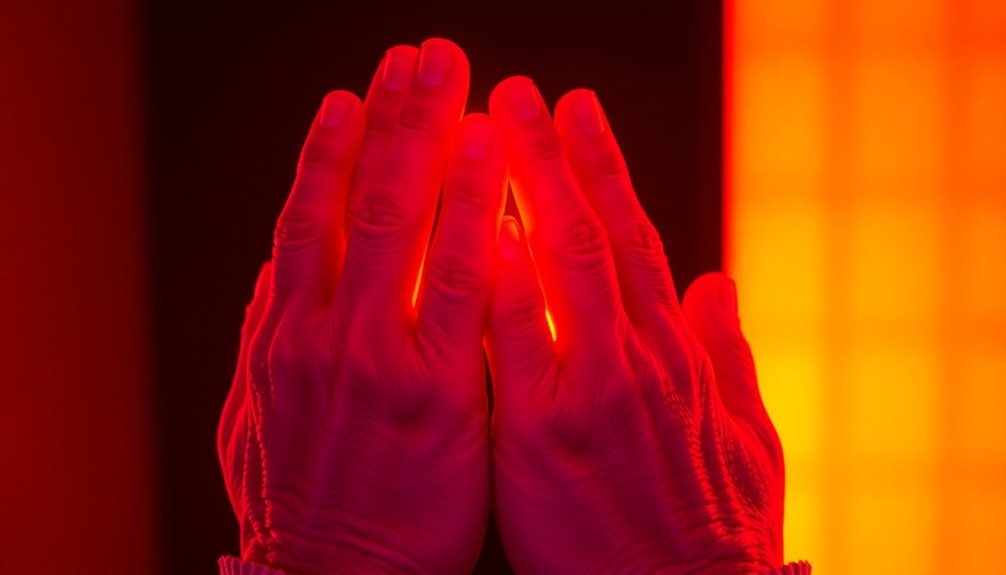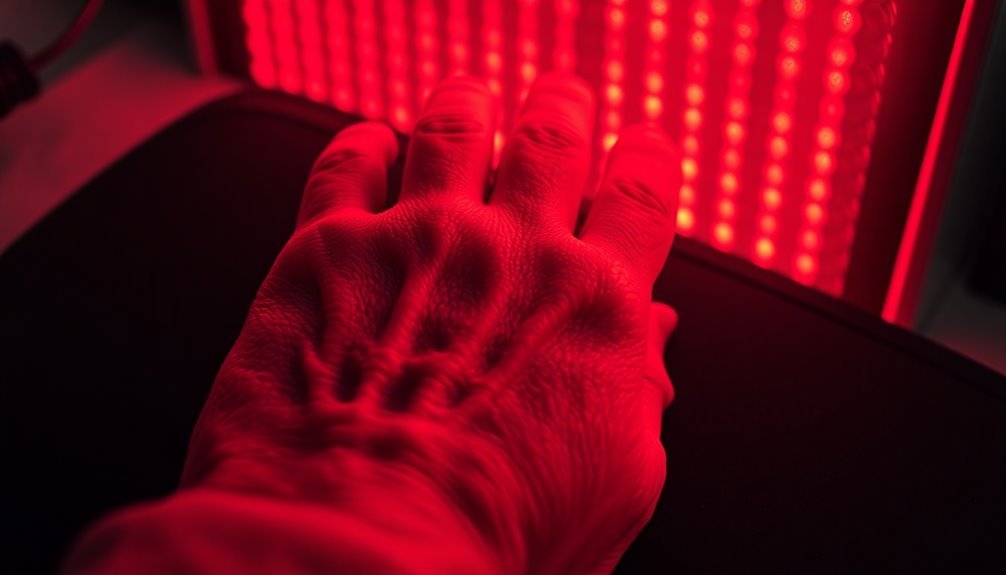Infrared therapy can effectively soothe your aching joints in five key ways. It penetrates 2-7 centimeters deep into your tissues, targeting pain at its source while triggering your body's natural painkillers. You'll experience reduced inflammation as the therapy improves blood flow and releases nitric oxide, relaxing your arteries. It accelerates cellular repair by boosting ATP production and collagen synthesis, helping rebuild damaged tissue. You'll notice improved joint mobility as the therapy reduces stiffness and enhances range of motion. The therapy also relaxes muscle spasms and promotes healing through increased circulation. Discover how this natural treatment could transform your joint health.
Deep Tissue Pain Relief

Through its remarkable penetrating power, infrared therapy reaches deep beneath the skin's surface to deliver effective pain relief for aching joints. Unlike traditional massage techniques, infrared rays can penetrate 2 to 7 centimeters into your tissues, targeting muscles, nerves, and bones that contribute to joint pain. This deep-reaching capability makes it particularly effective for conditions like osteoarthritis and chronic joint discomfort. Nitric oxide release during treatment helps relax arteries and regulate blood pressure naturally.
You'll find that infrared therapy's non-invasive nature sets it apart from deep tissue massage, as it can treat larger areas simultaneously without applying physical pressure. The therapy works by stimulating your body's natural pain-fighting mechanisms, triggering the release of endorphins that help reduce your discomfort.
When the infrared rays penetrate your tissues, they enhance blood flow to the affected areas, which helps reduce inflammation and promotes healing.
For thorough pain management, you can combine infrared therapy with other treatments. Its ability to reach deep tissue layers while remaining gentle on your body makes it an excellent choice for ongoing joint care, especially when you're dealing with persistent aches that haven't responded well to other treatments.
Inflammation Reduction Through Blood Flow
Blood vessels respond dramatically to infrared therapy's warming effects, expanding to increase circulation throughout your joints and surrounding tissues.
As your blood vessels dilate, you'll experience enhanced blood flow that delivers essential oxygen and nutrients directly to damaged areas, helping to reduce inflammation and accelerate healing.
When you undergo infrared therapy, it triggers the production of nitric oxide in your body, which naturally relaxes your arteries and improves circulation. This increased blood flow doesn't just temporarily ease your discomfort – it actively helps clear away inflammatory substances that contribute to joint pain and stiffness.
The deep-penetrating nature of infrared light means you're getting more than surface-level treatment. It reaches deep into your muscles, nerves, and bones, where it converts to cellular energy. This therapy can provide fast-acting pain relief within minutes of application.
Your body responds by producing more ATP, which powers the healing process at a cellular level. This enhanced cellular function helps your body repair damaged tissues more efficiently while reducing inflammation.
Through this improved circulation, you'll notice decreased swelling and inflammation in your joints, making everyday movements easier and less painful. It's a natural, non-invasive way to manage joint-related conditions without medication.
Natural Healing Process Enhancement

Your body's innate healing mechanisms get a powerful boost from infrared therapy, which works at the cellular level to enhance natural recovery processes. When you undergo infrared therapy, it stimulates your cells' ATP production and improves mitochondrial function, giving your cells the energy they need to repair and regenerate effectively. Far-infrared rays penetrate deep into your joints to provide therapeutic heat that enhances healing.
You'll experience accelerated tissue repair as the therapy enhances collagen production and cellular proliferation. This process is particularly beneficial for your aching joints, as it helps rebuild and strengthen damaged tissues.
The improved blood circulation you'll get from infrared therapy guarantees your cells receive essential nutrients and oxygen while efficiently removing waste products.
The therapy also triggers your body's natural pain-relief mechanisms. You'll benefit from increased endorphin production – your body's natural painkillers – while the enhanced nitric oxide levels help relax your arteries and reduce discomfort.
What's more, you're supporting your overall wellness as the therapy promotes detoxification and strengthens your immune function. It's a natural, non-invasive way to support your body's healing processes without the side effects often associated with conventional pain treatments.
Cellular Repair and Recovery
Restoration of damaged cells takes center stage during infrared therapy sessions, as the treatment activates powerful cellular repair mechanisms.
When you receive infrared therapy, it triggers your cells to produce more ATP, the essential energy source that powers cellular repair and regeneration. Research shows therapy sessions can cut pain by 50% in osteoarthritis patients. Your body's natural healing processes kick into high gear as the infrared light penetrates deep into your tissues.
You'll benefit from increased collagen production, which strengthens your joints and supports tissue repair. The therapy enhances blood circulation, delivering crucial nutrients and oxygen to damaged areas while stimulating nitric oxide production. This helps relax your arteries and combat harmful free radicals that can slow down healing.
Your cells' mitochondria become more efficient at producing energy, accelerating the recovery process. As the infrared light works its magic, you'll experience reduced inflammation and enhanced cellular signaling pathways.
The therapy also triggers the release of endorphins, your body's natural painkillers, providing relief while healing occurs.
With consistent treatment, you're investing in long-term joint health. Your cells become more resilient, better equipped to handle future stress, and maintain improved mobility through sustained cellular repair and regeneration.
Joint Mobility Improvement

Improved joint mobility stands as one of the most significant benefits of infrared therapy. When you're struggling with stiff, aching joints, infrared therapy enhances blood circulation, delivering essential nutrients and oxygen to damaged tissues.
Regular treatments can reduce recovery time significantly while supporting tissue repair and regeneration. This increased blood flow helps reduce inflammation and swelling while promoting cellular repair and collagen production.
You'll experience multiple therapeutic benefits as infrared light penetrates deep into your joints. It stimulates the production of endorphins, your body's natural painkillers, while encouraging the growth of new, healthy tissue.
The therapy's ability to boost collagen production is particularly important, as this protein provides critical support for joint structure and function.
- Your joints become more flexible as inflammation decreases
- Your range of motion improves due to enhanced blood circulation
- Your pain levels decrease through natural endorphin release
- Your joint structure strengthens with increased collagen production
- Your healing accelerates through improved cellular repair
FDA-cleared red light therapy devices now make it possible to receive these benefits at home. You can combine infrared therapy with traditional treatments for enhanced results, experiencing longer-lasting relief from joint pain and stiffness.
Frequently Asked Questions
How Long Does It Take to See Results From Infrared Therapy Treatments?
You'll notice initial pain relief after your first session, but expect significant results in 2-4 weeks with regular treatments. For maximum joint health benefits, continue sessions for 3-6 months of consistent use.
Can Infrared Therapy Be Used During Pregnancy for Joint Pain?
Yes, you can safely use infrared therapy during pregnancy for joint pain. It's non-invasive and won't cause thermal damage, but you'll need to avoid treatments on your belly and should consult your healthcare provider first.
What's the Difference Between LED and Infrared Therapy Devices?
You'll find LED therapy targets your skin's surface without heat, using visible light, while infrared therapy penetrates deeper into your tissues with thermal energy. LED's better for skin issues, infrared for muscle pain.
Are There Any Medications That Interfere With Infrared Therapy Treatments?
Yes, you'll need to be careful if you're taking photosensitizing medications or immunosuppressants. These drugs can increase light sensitivity and reduce treatment effectiveness. Always consult your healthcare provider before starting infrared therapy.
How Often Should Infrared Therapy Devices Be Replaced for Optimal Effectiveness?
You'll need to replace your infrared therapy device when it shows signs of degradation or after 10,000-50,000 hours of use. Monitor its performance and follow your manufacturer's guidelines for maximum effectiveness.
In Summary
You'll find infrared therapy offers a powerful, non-invasive way to manage joint pain and improve your overall mobility. Whether you're dealing with arthritis, sports injuries, or general joint stiffness, this natural treatment can help reduce inflammation, speed up healing, and restore function. Don't wait to experience relief – consider adding infrared therapy to your wellness routine and start feeling better today.





Leave a Reply